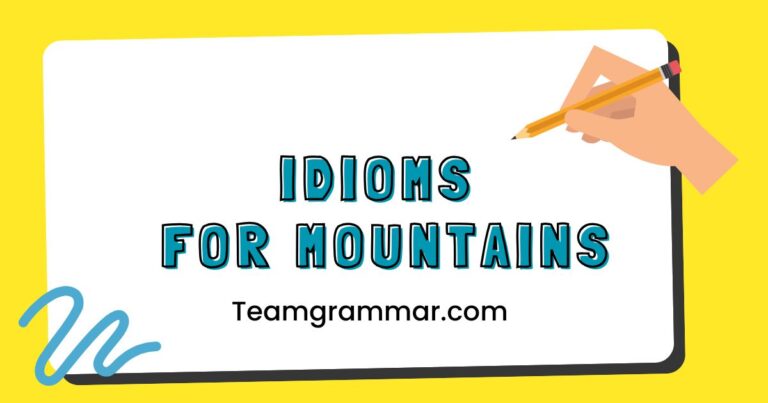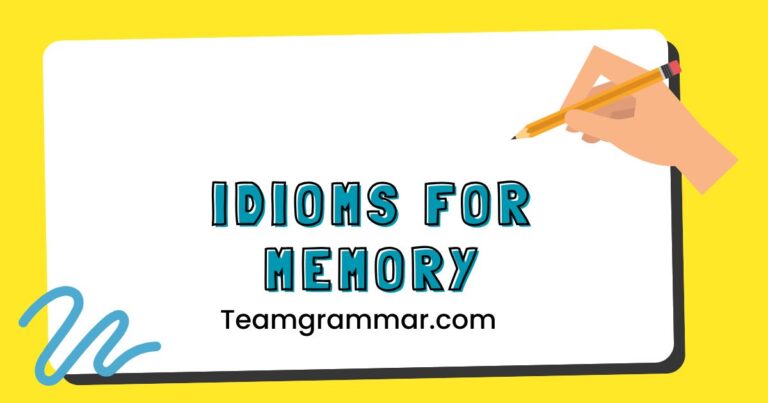37 Idioms for Leaders: Mastering English Figurative Language
Understanding idioms is crucial for mastering English, especially when discussing leadership qualities and actions. Idioms add color and depth to communication, allowing speakers to convey complex ideas in a concise and memorable way.
This article explores a variety of idioms related to leadership, providing definitions, examples, and practical exercises to help you confidently use them in your everyday speech and writing. Whether you’re an English language learner, a business professional, or simply someone interested in expanding your vocabulary, this guide will equip you with the knowledge and skills to effectively use leadership-related idioms.
This comprehensive guide is designed for English language learners, business professionals, and anyone interested in enhancing their understanding and use of idioms related to leadership. By exploring a range of idioms, their meanings, and practical applications, this article will empower you to communicate more effectively and confidently in various contexts.
Table of Contents
- Definition of Idioms for Leaders
- Structural Breakdown of Leadership Idioms
- Types and Categories of Leadership Idioms
- Examples of Idioms for Leaders
- Usage Rules for Leadership Idioms
- Common Mistakes When Using Leadership Idioms
- Practice Exercises
- Advanced Topics in Leadership Idioms
- Frequently Asked Questions
- Conclusion
Definition of Idioms for Leaders
An idiom is a phrase or expression whose meaning cannot be understood from the literal meanings of its individual words. Instead, it has a figurative meaning that is known through common usage.
Idioms related to leadership are phrases that describe actions, qualities, or situations commonly associated with leaders and leadership roles. These idioms enrich communication by adding nuance and cultural context, making it more engaging and impactful.
Idioms serve as a form of linguistic shorthand, conveying complex concepts in a succinct manner. They are deeply rooted in cultural understanding, often reflecting historical events, social norms, and shared experiences.
Using idioms effectively requires not only memorization but also an understanding of the context in which they are appropriate. Leadership idioms are particularly useful in business, politics, and organizational settings where effective communication is paramount.
Structural Breakdown of Leadership Idioms
Leadership idioms typically follow standard English grammatical structures but their meaning is derived from the figurative interpretation of the entire phrase. They can take various forms, including:
- Verb phrases: Take the reins (to assume control)
- Noun phrases: A guiding light (an inspirational leader)
- Prepositional phrases: At the helm (in charge)
- Adjectival phrases: On the ball (competent and alert)
The key to understanding leadership idioms lies in recognizing that the individual words do not contribute directly to the overall meaning. For example, the phrase “call the shots” doesn’t literally involve calling or shots; instead, it means to make the important decisions.
The structure of the idiom is grammatically correct, but its semantic content is idiomatic and requires familiarity.
Many leadership idioms also contain elements of metaphor, simile, or personification. For example, “steering the ship” is a metaphor that compares leading an organization to navigating a vessel.
This comparison helps to visualize the leader’s role in guiding and directing the team toward a specific destination. Recognizing these literary devices can aid in understanding and remembering the meaning of the idiom.
Types and Categories of Leadership Idioms
Leadership idioms can be categorized based on the specific aspect of leadership they describe. Here are some common categories:
Taking Charge
These idioms describe the act of assuming control or responsibility.
Decision Making
These idioms relate to the process of making important choices.
Influence and Persuasion
These idioms describe the ability to affect the actions or opinions of others.
Strategic Thinking
These idioms refer to the ability to plan and execute long-term goals.
Motivating Others
These idioms describe the act of inspiring and encouraging team members.
Examples of Idioms for Leaders
The following tables provide examples of leadership idioms, categorized by the aspect of leadership they represent. Each idiom is accompanied by its meaning and an example sentence.
Taking Charge
This table provides idioms related to taking charge as a leader. Each example includes the idiom, its meaning, and a usage example.
| Idiom | Meaning | Example Sentence |
|---|---|---|
| Take the reins | Assume control or leadership | After the CEO’s resignation, the vice president had to take the reins of the company immediately. |
| At the helm | In a position of leadership or control | With Sarah at the helm, the project is sure to be a success. |
| Call the shots | Make the important decisions | As the team leader, he gets to call the shots on this project. |
| Be in the driver’s seat | Be in control of a situation | Our marketing team is in the driver’s seat for the new campaign. |
| Run the show | Be in charge and make all the decisions | The project manager runs the show, making sure everything stays on track. |
| Take the bull by the horns | Confront a difficult situation directly and with courage | Faced with declining sales, she decided to take the bull by the horns and implement a new strategy. |
| Lead the charge | Be the first to take action or lead an effort | He led the charge in implementing the new technology across the company. |
| Take command | Assume authority and responsibility | In the crisis, the experienced officer took command and quickly restored order. |
| Stand at the forefront | Be in a leading position, especially in an important movement or development. | Our company stands at the forefront of innovation in the renewable energy sector. |
| Be at the wheel | Be in control or directing something | With John at the wheel, we are confident that the company will navigate these challenges successfully. |
| Seize the initiative | Take control by being the first to act | Recognizing the opportunity, she seized the initiative and proposed a new marketing plan. |
| Steer the ship | Guide or direct an organization or project | The CEO’s vision is to steer the ship towards sustainable growth and innovation. |
| Wear the pants | Be the dominant or controlling person (often in a relationship or organization) | In that company, the marketing director really wears the pants and makes all the important decisions. |
| Hold the reins | Maintain control or leadership | The experienced manager continues to hold the reins, ensuring stability and progress. |
| Call the tune | Be in a position to make the important decisions | Since he’s the primary investor, he gets to call the tune on how the business is run. |
| Head up | Lead or be in charge of a team, project, or organization | She was chosen to head up the new research division due to her expertise in the field. |
| Be in charge | Have control or authority over something | He is in charge of the entire department, overseeing all operations and personnel. |
| Take charge of | Assume control and responsibility for something | She decided to take charge of the situation and implement changes to improve efficiency. |
| At the head of | Leading or directing something | He stood at the head of the procession, guiding everyone toward the destination. |
| Be at the top | Be in the highest position of authority or control | After years of hard work, she finally made it to the top of the corporate ladder. |
| Sit at the top | Occupy the highest position of authority or control | He sits at the top of the organization, making strategic decisions that affect the entire company. |
| Take over | Assume control or responsibility, often after someone else | When the founder retired, his daughter took over the family business. |
| Be at the controls | Be in a position to direct or manage something | With the new software, the team is at the controls, able to monitor and adjust performance in real-time. |
| Be in the saddle | Be in control of a situation, especially after a period of uncertainty | Now that he’s in the saddle, he can start implementing his new strategies for growth. |
| Hold sway | To have power or influence over someone or something | The chairman’s opinion continues to hold sway over the board’s decisions. |
Decision Making
This table provides idioms related to decision-making skills in leadership. Each example includes the idiom, its meaning, and a usage example.
| Idiom | Meaning | Example Sentence |
|---|---|---|
| Weigh the options | Carefully consider all possible choices | Before making a final decision, it’s important to weigh the options carefully. |
| Make a call | Make a decision | After considering all the factors, the manager had to make a call on the budget. |
| Bite the bullet | Face a difficult or unpleasant situation with courage | The company had to bite the bullet and lay off some employees to stay afloat. |
| Draw the line | Set a limit or boundary | The manager had to draw the line at employees using company resources for personal projects. |
| Go with your gut | Trust your intuition or instinct | Sometimes you have to go with your gut when making business decisions, even if the data isn’t clear. |
| Think outside the box | Come up with creative or unconventional solutions | To solve the problem, we need to think outside the box and consider new approaches. |
| Put your foot down | Assert your authority and refuse to allow something | The supervisor had to put his foot down and stop the constant disruptions in the office. |
| Read between the lines | Understand the hidden or implied meaning | To truly understand the situation, you need to read between the lines and consider the unspoken concerns. |
| Take stock | Review or assess a situation carefully | Before moving forward, we need to take stock of our progress and identify any areas for improvement. |
| Make up your mind | Decide something | He needs to make up his mind quickly so we can proceed with the project. |
| Take a stand | Publicly support or defend a particular cause or belief | The CEO decided to take a stand against the proposed regulations, despite the potential backlash. |
| Cross that bridge when you come to it | Deal with a problem or situation when it arises | We don’t need to worry about the logistics yet; we’ll cross that bridge when we come to it. |
| Sit on the fence | Remain neutral or undecided | The politician refused to sit on the fence and took a clear position on the issue. |
| Jump the gun | Start doing something too soon, before the right time | They jumped the gun by launching the product before the marketing campaign was ready. |
| Go out on a limb | Take a risk by expressing an unpopular opinion or taking a bold action | He went out on a limb by supporting the controversial proposal, but it ultimately paid off. |
| Back to the drawing board | Start over from the beginning, often after a failed attempt | The initial design didn’t work, so it’s back to the drawing board for the engineering team. |
| Call an audible | Change a plan or strategy at the last minute, often in response to unexpected circumstances | Seeing the market shift, the company had to call an audible and adjust its marketing strategy. |
| Take a gamble | Take a risk in the hope of gaining an advantage | Investing in the new technology was a gamble, but it had the potential for high returns. |
| Cut your losses | Stop investing time or money in something that is not succeeding | Recognizing the project was failing, the team decided to cut their losses and move on to other opportunities. |
| Play your cards right | Act strategically to achieve a desired outcome | If we play our cards right, we can secure the contract and expand our business. |
| Put all your eggs in one basket | Risk everything on a single venture | It’s risky to put all your eggs in one basket; we should diversify our investments. |
| Take the plunge | Make a bold decision or commitment | After months of consideration, they decided to take the plunge and start their own business. |
| Test the waters | Try something new carefully to see if it is likely to be successful | Before launching the product nationwide, we need to test the waters in a smaller market. |
| Get the ball rolling | Start something | Let’s get the ball rolling on this project by setting up an initial meeting with the team. |
| Bite off more than you can chew | Take on more responsibilities than you can handle | He bit off more than he could chew when he volunteered to manage three projects simultaneously. |
Influence and Persuasion
This table provides idioms related to influence and persuasion in a leadership role. Each example includes the idiom, its meaning, and a usage example.
| Idiom | Meaning | Example Sentence |
|---|---|---|
| Twist someone’s arm | Persuade someone to do something they are reluctant to do | I didn’t want to work overtime, but my boss twisted my arm. |
| Have a way with words | Be skilled at speaking or writing persuasively | The politician has a way with words that captivates audiences. |
| Sell an idea | Convince someone of the merits of an idea | The entrepreneur had to sell his idea to investors to secure funding. |
| Win someone over | Persuade someone to support you or your cause | The charismatic leader was able to win the team over to his vision. |
| Get your foot in the door | Get a first opportunity to prove yourself | Interning at the company was a great way to get my foot in the door. |
| Pull strings | Use your influence to get something done | He had to pull some strings to get the project approved quickly. |
| Carry weight | Have influence or importance | His opinion carries a lot of weight in the company because of his experience. |
| Hold water | Be logical or consistent | His argument didn’t hold water when examined closely. |
| Be a smooth talker | Be skilled at persuading people with charming words | The salesperson was a smooth talker and easily convinced customers to buy the product. |
| Get through to someone | Make someone understand your message | It was hard to get through to him, but eventually, he understood the importance of the project. |
| Have someone eating out of your hand | Have someone completely under your control or influence | The charismatic speaker had the audience eating out of his hand with his compelling stories. |
| Turn the tide | Reverse a negative trend or situation | The new marketing campaign helped to turn the tide and increase sales. |
| Pave the way | Make it easier for something to happen in the future | Her research paved the way for new advancements in medical technology. |
| Sway someone’s opinion | Change someone’s view or belief | The compelling evidence helped to sway the jury’s opinion. |
| Make a case for | Present a strong argument in favor of something | The lawyer made a strong case for his client’s innocence. |
| Have the gift of the gab | Be able to speak easily and persuasively | The politician used the gift of the gab to win over the voters. |
| Plant a seed | Introduce an idea gradually to someone’s mind | He planted a seed about the new project during the meeting, hoping it would gain traction. |
| Get someone on board | Convince someone to support a project or idea | The manager worked hard to get the team on board with the new strategy. |
| Twist the facts | Present information in a misleading way | The politician was accused of twisting the facts to suit his agenda. |
| Drive home a point | Emphasize a point strongly | The speaker used several examples to drive home the point about the importance of teamwork. |
| Leave a lasting impression | Create a memorable and impactful effect | The CEO’s speech left a lasting impression on the employees. |
| Lay down the law | State a rule or requirement firmly and authoritatively | The principal had to lay down the law to address the students’ disruptive behavior. |
| Have the upper hand | Have an advantage or position of control | In the negotiation, our team had the upper hand due to our superior technology. |
| Turn heads | Attract attention or admiration | The innovative design of the product turned heads at the trade show. |
| Bend someone to your will | Force someone to do what you want | The dictator tried to bend the population to his will through propaganda and intimidation. |
Strategic Thinking
This table provides idioms related to strategic thinking for effective leadership. Each example includes the idiom, its meaning, and a usage example.
| Idiom | Meaning | Example Sentence |
|---|---|---|
| See the big picture | Understand the overall context and implications | A good leader needs to see the big picture to make informed decisions. |
| Plan ahead | Prepare for the future | The company needs to plan ahead to stay competitive in the market. |
| Think long-term | Consider the future consequences of your actions | Strategic leaders think long-term and invest in sustainable growth. |
| Stay one step ahead | Anticipate future developments and be prepared | To succeed in this industry, you need to stay one step ahead of the competition. |
| Map out a strategy | Develop a detailed plan to achieve a goal | The team worked together to map out a strategy for the upcoming marketing campaign. |
| Keep your eye on the ball | Stay focused on your goal | It’s important to keep your eye on the ball and not get distracted by minor issues. |
| Play the long game | Focus on achieving long-term goals rather than short-term gains | Successful investors play the long game and don’t panic during market fluctuations. |
| Look down the road | Think about the future | When making decisions, it’s essential to look down the road and anticipate potential challenges. |
| Read the tea leaves | Interpret subtle signs to predict future events | Analysts tried to read the tea leaves to predict the outcome of the election. |
| Connect the dots | Understand how different pieces of information are related | The detective was able to connect the dots and solve the mystery. |
| Have a game plan | Have a strategy or plan of action | The team entered the competition with a well-defined game plan. |
| Set the stage | Prepare the conditions for something to happen | The new policies set the stage for economic growth. |
| Take a bird’s-eye view | Look at a situation from a high level to gain a broad perspective | The consultant advised the company to take a bird’s-eye view of their operations to identify inefficiencies. |
| See the forest for the trees | Understand the overall situation rather than focusing on details | It’s important to see the forest for the trees when managing a complex project. |
| Lay the groundwork | Prepare the foundation for future success | The initial research laid the groundwork for the groundbreaking discovery. |
| Think on your feet | React quickly and effectively to unexpected situations | A good leader needs to think on their feet in a crisis. |
| Anticipate the curve | Predict future trends or changes | Successful companies anticipate the curve and adapt their strategies accordingly. |
| Chart a course | Plan a route or direction to achieve a goal | The team worked together to chart a course for the company’s future growth. |
| Look ahead | Think about and plan for the future | The CEO urged the employees to look ahead and focus on long-term objectives. |
| Think globally | Consider the international implications of your actions | Businesses need to think globally to succeed in today’s interconnected world. |
| Put the pieces together | Assemble information to form a coherent picture | The analyst was able to put the pieces together and identify the underlying trends in the market. |
| Size up the situation | Assess or evaluate a situation carefully | Before making a decision, it’s important to size up the situation and consider all the factors. |
| Have a vision | Have a clear idea of what you want to achieve in the future | The entrepreneur had a vision of creating a company that would revolutionize the industry. |
| On the horizon | Likely to happen or appear soon | New opportunities are on the horizon for the company. |
| Read the writing on the wall | Recognize that something is likely to fail or end | The manager read the writing on the wall and started looking for a new job before the company went bankrupt. |
Motivating Others
This table provides idioms related to motivating others in leadership. Each example includes the idiom, its meaning, and a usage example.
| Idiom | Meaning | Example Sentence |
|---|---|---|
| Light a fire under someone | Motivate or energize someone to take action | The coach’s pep talk lit a fire under the team, and they won the game. |
| Lead by example | Inspire others by demonstrating the desired behavior | A good leader leads by example, showing the team how to work hard and stay committed. |
| Pat on the back | Give praise or encouragement | The manager gave the employee a pat on the back for his outstanding performance. |
| Go the extra mile | Do more than what is expected | The team always goes the extra mile to ensure customer satisfaction. |
| Keep spirits up | Maintain a positive attitude and encourage others to do the same | The captain tried to keep spirits up during the difficult journey. |
| Give someone a pep talk | Give someone encouragement and motivation | The coach gave the team a pep talk before the big game. |
| Set the tone | Establish a particular mood or attitude | The leader set the tone for the meeting by starting with a positive message. |
| Inspire confidence | Make others believe in their abilities | The mentor’s guidance helped to inspire confidence in the student. |
| Bring out the best in someone | Help someone to perform at their highest potential | The supportive environment brought out the best in the employees. |
| Rally the troops | Gather support and motivate people to work together | The manager rallied the troops to meet the challenging deadline. |
| Keep the ball rolling | Maintain momentum and progress | Let’s keep the ball rolling on this project to ensure we finish on time. |
| Push someone’s buttons | Provoke or irritate someone intentionally | The colleague pushed his buttons with constant criticism. |
| Give someone a leg up | Give someone an advantage or opportunity | The internship gave her a leg up in the competitive job market. |
| Be a driving force | Be a major influence or motivator | The CEO’s vision was a driving force behind the company’s success. |
| Set an example | Behave in a way that others can imitate positively | The teacher set an example of hard work and dedication for her students. |
| Encourage risk-taking | Promote a culture where people are willing to try new things | The company encourages risk-taking to foster innovation. |
| Foster collaboration | Promote teamwork and cooperation | The manager fosters collaboration by organizing team-building activities. |
| Give credit where it’s due | Acknowledge and praise someone’s contributions | It’s important to give credit where it’s due to recognize the team’s hard work. |
| Build morale | Improve the confidence and enthusiasm of a group | The company organized a fun event to build morale among the employees. |
| Empower others | Give someone the authority or power to do something | The leader empowers others by delegating responsibilities and providing support. |
| Fuel the fire | Encourage or intensify something | The positive feedback fueled the fire, motivating the team to work even harder. |
| Get behind someone | Support or encourage someone | The community got behind the candidate, helping him win the election. |
| Lift someone up | Encourage or support someone who is struggling | The mentor tried to lift up the student by offering guidance and encouragement. |
| Put wind in someone’s sails | Encourage or inspire someone | The positive review put wind in the author’s sails, motivating him to write more. |
| Shape up or ship out | Improve your performance or leave | The manager told the underperforming employees to shape up or ship out. |
Usage Rules for Leadership Idioms
When using leadership idioms, it’s important to consider the context and audience. Overusing idioms can make your communication sound unnatural or cliché.
Here are some guidelines:
- Know your audience: Ensure your audience understands the idioms you’re using. Avoid idioms that may be unfamiliar or confusing to non-native speakers.
- Context matters: Use idioms appropriately in the context of the conversation or writing. An idiom that is suitable for a casual discussion may not be appropriate for a formal presentation.
- Avoid overuse: Use idioms sparingly to add emphasis and color to your communication. Overusing them can make your message sound contrived.
- Be accurate: Ensure you understand the correct meaning and usage of the idiom. Using an idiom incorrectly can lead to miscommunication.
Another important consideration is the level of formality. Some idioms are more informal and suitable for casual conversations, while others are more formal and appropriate for professional settings.
Consider the tone and purpose of your communication when selecting idioms.
Common Mistakes When Using Leadership Idioms
One common mistake is misinterpreting the meaning of an idiom. For example, some might think “take the reins” literally involves holding reins, rather than understanding it means to assume control.
Another mistake is using idioms in the wrong context, such as using a casual idiom in a formal presentation.
Another frequent error involves using the wrong form of the idiom. Idioms are fixed expressions, and changing the words can alter or negate their meaning.
For example, saying “catch the bull by the horns” instead of “take the bull by the horns” is incorrect.
Here are some examples of common mistakes and their corrections:
| Incorrect | Correct |
|---|---|
| He catched the bull by the horns. | He took the bull by the horns. |
| She is in the wheel. | She is at the wheel. |
| They are calling the tunes. | He calls the tune. |
| He weighted the options. | He weighed the options. |
Practice Exercises
Test your understanding of leadership idioms with these exercises. Fill in the blanks with the appropriate idiom from the list provided.
Idiom List: take the reins, call the shots, think outside the box, bite the bullet, lead by example, get the ball rolling, weigh the options, get your foot in the door, keep your eye on the ball, take the plunge
| Question | Answer |
|---|---|
| 1. After the manager left, Sarah had to ________ and manage the team. | take the reins |
| 2. As the project leader, he gets to ________ and decide the direction we take. | call the shots |
| 3. To find a new solution, we need to ________ and come up with something creative. | think outside the box |
| 4. The company had to ________ and cut costs to stay afloat. | bite the bullet |
| 5. A good leader should ________ and show others how to work hard. | lead by example |
| 6. Let’s ________ on this project by setting up an initial meeting. | get the ball rolling |
| 7. Before making a decision, it’s important to ________ and consider all the possibilities. | weigh the options |
| 8. Interning at the company was a great way to ________ and start my career. | get your foot in the door |
| 9. It’s important to ________ and stay focused on your goals. | keep your eye on the ball |
| 10. After months of planning, they decided to ________ and start their own business. | take the plunge |
Exercise 2: Match the idioms to their meanings.
| Idiom | Meaning |
|---|---|
| 1. Steer the ship | a. Make a decision |
| 2. Make a call | b. Be in control or directing something |
| 3. Have a way with words | c. Confront a difficult situation directly |
| 4. Take the bull by the horns | d. Be skilled at speaking persuasively |
| 5. Light a fire under someone | e. Motivate someone to take action |
Answers: 1-b, 2-a, 3-d, 4-c, 5-e
Exercise 3: Choose the correct idiom to complete the sentence.
- The manager had to ________ when the team missed the deadline.
- a) put his foot down
- b) jump the gun
- c) sit on the fence
- The CEO decided to ________ and support the controversial policy.
- a) take a stand
- b) weigh the options
- c) call the shots
- To stay competitive, the company needs to ________ and anticipate future trends.
- a) read the tea leaves
- b) connect the dots
- c) anticipate the curve
Answers: 1-a, 2-a, 3-c
Advanced Topics in Leadership Idioms
For advanced learners, exploring the etymology and historical context of leadership idioms can provide a deeper understanding of their meanings and cultural significance. Many idioms have roots in historical events, literature, or folklore.
Understanding these origins can enhance your appreciation and usage of the idioms.
Another advanced topic is the adaptation and evolution of idioms over time. Language is dynamic, and idioms can change in meaning or usage as society evolves.
Staying current with these changes will ensure that you’re using idioms correctly and effectively.
Furthermore, exploring the use of idioms in different dialects and regional variations of English can provide insights into cultural differences and linguistic diversity. Some idioms may be more common or have slightly different meanings in different regions.
Frequently Asked Questions
Conclusion
Mastering leadership idioms is a valuable skill for anyone looking to enhance their communication and influence in professional settings. By understanding the meanings, origins, and usage rules of these idioms, you can add nuance, color, and cultural context to your speech and writing.
Remember to use idioms appropriately, considering your audience and context, and avoid common mistakes. With practice and dedication, you can confidently use leadership idioms to express complex ideas and inspire others.







